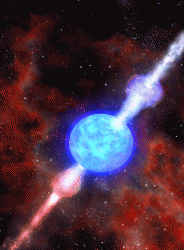 Spiral galaxy NGC 2770 with two supernovae SN 2007uy and SN 2008D. Credit: NASA
Spiral galaxy NGC 2770 with two supernovae SN 2007uy and SN 2008D. Credit: NASAJust when we thought we were beginning to understand what supernovae and gamma ray bursts were all about. Astronomers have just uncovered the true nature of what they thought was a regular supernova observed in January. At the time, it looked like a supernova emitting a 5-minute long burst of X-rays. But these X-rays were of a lower energy (known as "soft" X-rays) than expected leading some to believe this was a normal emission from a supernova explosion that was being observed during detonation (astronomers don't usually get the chance to observe a star as it explodes and usually have to make do with analysing the supernova remnant). However, it is now believed this strange supernova event may have been emissions from a dying star at an intermediate mass, neither producing a supernova nor a gamma ray burst, but a combination of both…
Orbiting above Earth on January 9th 2008, the NASA/STFC/ASI Swift telescope caught a rare glimpse of what seemed to be a "normal" supernova at the precise moment of detonation. This observation was completely by luck, as Swift was already observing a supernova remnant (SN 2007uy) in spiral galaxy NGC 2770 that had exploded the previous year (90 million light-years away near the Lynx constellation). Then, as Swift was retrieving data from the SN 2007uy remnant, SN 2008D blasted a 5-minute long burst of X-rays in the same galaxy making this the first supernova to be directly observed.
However, looks can be deceiving. Researchers from a host of institutions including Italian National Institute for Astrophysics (INAF), the Max-Planck Institute for Astrophysics (MPA) and the European Southern Observatory (ESO) have analysed the supernova data thoroughly and at first agreed with the original assessment that it was indeed "normal."
"What made this event very interesting is that the X-ray signal was very weak and 'soft', very different from a gamma-ray burst and more in line with what is expected from a normal supernova." - Paolo Mazzali, INAF's Padova Observatory/MPA, research leader.
However, astronomers at the Asiago Observatory in Northern Italy had designated the event as a Type 1c supernova, more commonly associated with long-period gamma-ray bursts. Type 1c supernovae are generated by hydrogen-poor progenitor stars with helium-rich outer layers prior to exploding at the end of their lives. But SN 2008D generated soft X-rays more associated with smaller stellar explosions. Therefore SN 2008D was probably produced by a star that was massive at birth (approximately 30 solar masses), rapidly using up its hydrogen fuel in its short life until it was only 8-10 solar masses. At this point it exploded, probably creating a remnant black hole. This chain of thought has led Paolo Mazzali and his team to think SN 2008D was produced by an object of a mass at the boundary of a normal supernova and gamma-ray burst.
"Since the masses and energies involved are smaller than in every known gamma-ray burst related supernova, we think that the collapse of the star gave rise to a weak jet, and that the presence of the Helium layer made it even more difficult for the jet to remain collimated, so that when it emerged from the stellar surface the [X-ray] signal was weak." - Massimo Della Valle, co-investigator.
Researcher and co-author Stefano Valenti points out that this discovery indicates that all black hole-producing supernovae have the potential to be gamma-ray burst progenitors. "The scenario we propose implies that gamma-ray burst-like inner engine activity exists in all supernovae that form a black hole," he added.




No comments:
Post a Comment